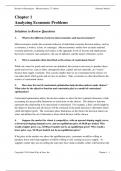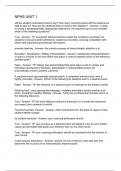Besanko & Braeutigam – Microeconomics, 5th edition Solutions Manual Copyright © 2014 John Wiley & Sons, Inc. Chapter 1 - 1 Chapter 1 Analyzing Economic Problems Solutions to Review Questions 1. What is the difference between microeconomics and macroeconomics? Microeconomics studies the economic behavior of individual economic decision makers, such as a consumer, a worker, a firm, or a manager. Macroeconomics studies how an entire national economy performs, examining such topics as the aggregate levels of income and employment, the levels of interest rates and prices, the rate of inflation, and the nature of business cycles. 2. Why is economics often described as the science of constrained choice? While our wants for goods and services are unlimited, the resources necessary to produce those goods and services, such as labor, managerial talent, capital, and raw materials, ar e “scarce” because their supply is limited. This scarcity implies that we are constrained in the choices we can make about which goods and services to produce. Thus, economics is often described as the science of constrained choice. 3. How does the tool of constrained optimization help decision makers make choices? What roles do the objective function and constraints play in a model of constrained optimization? Constrained optimization allows the decision maker to select the best (optimal) alternative w hile accounting for any possible limitations or restrictions on the choices. The objective function represents the relationship to be maximized or minimized. For example, a firm’s profit might be the objective function and all choices will be evaluated i n the profit function to determine which yields the highest profit. The constraints place limitations on the choice the decision maker can select and defines the set of alternatives from which the best will be chosen. 4. Suppose the market for wheat is c ompetitive, with an upward -sloping supply curve, a downward -sloping demand curve, and an equilibrium price of $4.00 per bushel. Why would a higher price (e.g., $5.00 per bushel) not be an equilibrium price? Why would a lower price (e.g., $2.50 per bushel) not be an equilibrium price? If the price in the market was above the equilibrium price, consumers would be willing to purchase fewer units than suppliers would be willing to sell, creating an excess supply. As suppliers realize they are not selling the units they have made available, sellers will bid down the Besanko & Braeutigam – Microeconomics, 5th edition Solutions Manual Copyright © 2014 John Wiley & Sons, Inc. Chapter 1 - 2 price to entice more consumers to purchase their goods or services. By definition, equilibrium is a state that will remain unchanged as long as exogenous factors remain unchanged. Since in this case suppliers will lower their price, this high price cannot be an equilibrium. When the price is below the equilibrium price, consumers will demand more units than suppliers have made available. This excess demand will entice consumers to bid up the pric es to purchase the limited units available. Since the price will change, it cannot be an equilibrium. 5. What is the difference between an exogenous variable and an endogenous variable in an economic model? Would it ever be useful to construct a model th at contained only exogenous variables (and no endogenous variables)? Exogenous variables are taken as given in an economic model, i.e., they are determined by some process outside the model, while endogenous variables are determined within the economic model being studied. An economic model that contained no endogenous variables would not be very interesting. With no endogenous variables, nothing would be determined by the model so it would not serve much purpose. 6. Why do economists do comparative st atics analysis? What role do endogenous variables and exogenous variables play in comparative statics analysis? Comparative statics analyses are performed to determine how the levels of endogenous variables change as some exogenous variable is changed. T his type of analysis is very important since in the real world the exogenous variables, such as weather, policy tools, etc. are always changing and it is useful to know how changes in these variables affect the levels of other, endogenous, variables. An example of comparative statics analysis would be asking the question: If extraordinarily low rainfall (an exogenous variable) causes a 30 percent reduction in corn supply, by how much will the market price for corn (an endogenous variable) increase? 7. Wha t is the difference between positive and normative analysis? Which of the following questions would entail positive analysis, and which normative analysis? a) What effect will Internet auction companies have on the profits of local automobile dealerships? b) Should the government impose special taxes on sales of merchandise made over the Internet? Positive analysis attempts to explain how an economic system works or to predict how it will change over time by asking explanatory or predictive questions. Nor mative analysis focuses on what should be done by asking prescriptive questions. Besanko & Braeutigam – Microeconomics, 5th edition Solutions Manual Copyright © 2014 John Wiley & Sons, Inc. Chapter 1 - 3 a) Because this question asks whether dealership profits will go up or down (and by how much) – but refrains from inquir ing as to whether this would be a good thing – it is an example of p ositive analysis . b) On the other hand, this question asks whether it is desirable to impose taxes on Internet sales, so it is n ormative analysis . Notably, this question does not ask what the effect of such taxes would be. Solutions to P roblems 1.1 Discuss the following statement: “Since supply and demand curves are always shifting, markets never actually reach an equilibrium. Therefore, the concept of equilibrium is useless.” While the claim that markets never reach an equilibrium is p robably debatable, even if markets do not ever reach equilibrium, the concept is still of central importance. The concept of equilibrium is important because it provides a simple way to predict how market prices and quantities will change as exogenous var iables change. Thus, while we may never reach a particular equilibrium price, say because a supply or demand schedule shifts as the market moves toward equilibrium, we can predict with relative ease, for example, whether prices will be rising or falling w hen exogenous market factors change as we move toward equilibrium. As exogenous variables continue to change , we can continue to predict the direction of change for the endogenous variables, and this is not “useless.” 1.2 In an article entitled, “Corn Pr ices Surge on Export Demand, Crop Data,” The Wall Street Journal identified several exogenous shocks that pushed U.S. corn prices sharply higher. (See the article by Aaron Lucchetti, August 22, 1997, p. C17. on national income. ) Suppose the U.S. market for corn is competitive, with an upward -sloping supply curve and a downward -
sloping demand curve. For each of the following scenarios, illustrate graphically how the exogenous event described will contribute to a higher price of corn in the U.S. market. a) The U.S. Department of Agriculture announces that exports of corn to Taiwan and Japan were “surprisingly bullish,” around 30 percent higher than had been expected. b) Some analysts project that the size of the U.S. corn crop will hit a six -year low because of dry weather. c) The strengthening of El Niño, the meteorological trend that brings warmer weather to the western coast of South America, reduces corn production outside the United States, thereby increasing foreign countries’ dependence on the U.S. corn c rop. Besanko & Braeutigam – Microeconomics, 5th edition Solutions Manual Copyright © 2014 John Wiley & Sons, Inc. Chapter 1 - 4 a) Surprisingly high export sales mean that the demand for corn was higher than expected, at D 2 rather than D 1. b) Dry weather would reduce the supply of corn, to S 2 rather than S 1. c) Assuming the U.S. does not import corn, reduced production outside the U.S. would not impact U.S. corn ma rket supply. El Nino would, however , cause demand for U.S. corn to shift out, the figure being the same as in part (a) above. 1.3 In early 2008, the price of oil on the world market increased, hitting a peak of about $140 per barrel in July, 2008. In the second half of 2008, the price of oil declined, ending the year at just over $40 p er barrel. Suppose that the global market for oil can be described by an upward -sloping supply curve and a downward -sloping demand curve. For each of the following scenarios, illustrate graphically how the exogenous event contributed to a rise or a decline in the price of oil in 2008: P Q S D1 D2 P1 P2 S1 S2 P Q D P1 P2





